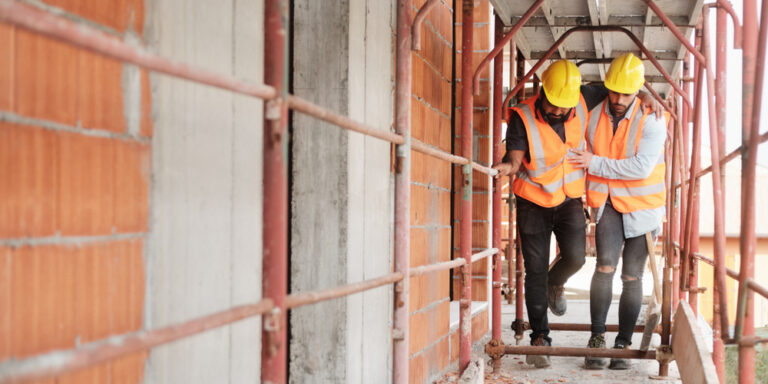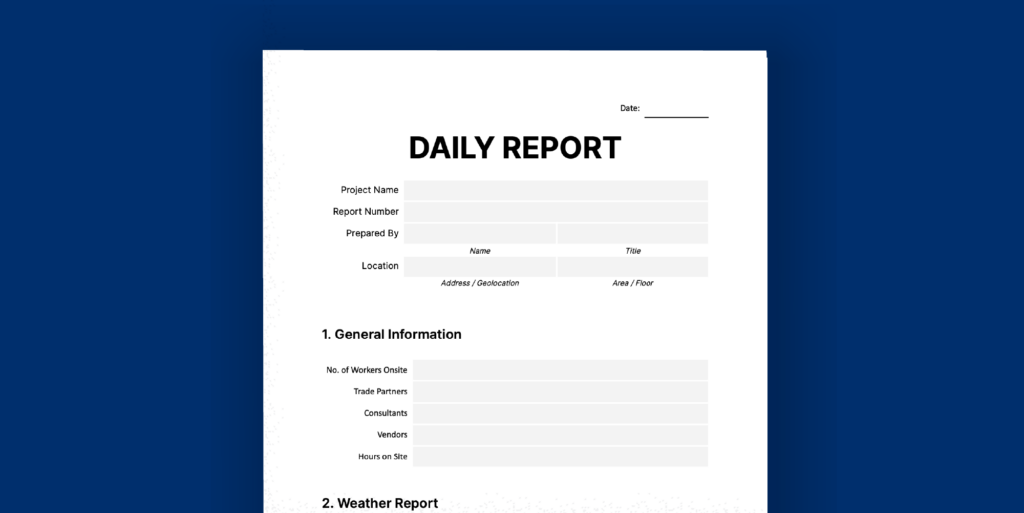— 6 min read
Construction Incident Report: Not Just For Injuries

Last Updated Jul 31, 2025

Jonny Finity
Senior Content Manager
28 articles
Jonny Finity creates and manages educational content at Procore. In past roles, he worked for residential developers in Virginia and a commercial general contractor in Bar Harbor, Maine. Jonny holds a BBA in Financial Economics from James Madison University. He lives in New Orleans.
Last Updated Jul 31, 2025

Accidents happen, and even best-laid plans can go wrong. As the construction industry continues evolving rapidly to build faster than ever before, incidents can still occur on the most proactive of job sites.
While you can’t always prevent accidents from happening, you can arm yourself with the tools to respond quickly and thoroughly when they do. A watertight construction incident report is essential so that you can identify future risks and develop better safety procedures.
Table of contents
Details matter: Getting a construction incident report correct
Responding to an incident on the job site can seem daunting. However, properly documenting the incident — even in a stressful environment — is critical. Doing so can keep projects on track, mitigate risk, avoid OSHA violations or penalties, and demonstrate your company’s commitment to keeping your workers healthy and safe.
Over the years, there has been a rise in the awareness and tracking of incident rates as a powerful metric to benchmark a company’s safety performance. In fact, poor rates can lead to more surprise OSHA inspections and higher insurance premiums.
Courses about construction.
For construction.
Unlock your career potential with our free educational courses on Health & Safety, Data in Construction, and more.
Types of construction site incidents
It’s no secret that construction can be dangerous. Working on a job site carries inherent risk due to the sheer volume of potential dangers present at all times. According to the National Safety Council and OSHA, in the U.S., a worker is injured on the job every seven seconds. Construction’s “Fatal Four”— falls, struck by object, electrocution, and caught-in/between — accounted for more than half of construction worker deaths in 2018.
Keep reading to learn more about some common buckets that reportable events can fall under.
Learn more: The most common causes of construction accidents
Serious/catastrophic events
An unexpected accident that results in death, permanent harm, severe, temporary harm, psychological injury, or the risk thereof, is considered a serious/catastrophic event. Typical examples of such injuries include the “Fatal Four” mentioned above as well as a scaffolding collapse that results in hospitalization, the loss of a limb, or loss of motor function.
First aid-only events
Minor cuts, scrapes, burns, or injuries that happen on the job that don’t require a trip to the doctor fall into the bucket of first aid-only events. In other words, health and safety services are administered on the job site.
Medical-only events
A medical-only event is when someone seeks medical treatment beyond first aid, but it does not result in hospitalization, lost time from work, or permanent injury. For instance, a worker visits the doctor to see if they need stitches, but finds out they are not necessary.
Recordable events
Recordable events can be those that result in death, days away from work, restricted work, transfer to another job, medical treatment beyond first aid, or loss of consciousness. Injuries and illnesses include any work-related diagnosed case of cancer, chronic irreversible diseases, fractured or cracked bones or teeth, or punctured eardrums.
Report-only events
According to OSHA and the NSC, near misses are a common type of report-only event — they could have led to bodily harm and/or property loss but didn’t (for instance, if a hammer falls from scaffolding and nearly hits someone on the head). Near miss incidents often precede loss producing events, but they may be overlooked since there was no harm at the time.
Lost-time events
A lost time event is when an occupational injury or illness prevents someone from being able to work their normal shifts. An example is someone who shatters their ankle after falling off a ladder and can’t return to work for a month.
Incident report forms & templates
The primary purpose of a construction incident report is to uncover the circumstances and conditions that led to an event to help prevent similar future incidents in the future. Depending on the severity of the incident, the report may be circulated within the company or externally to insurers, regulatory bodies, and possibly others. Properly evaluating and selecting the right form will make all the difference from the get-go and ensure all critical information is included.
OSHA publishes three forms for recording incidents:
- Form 301: Injury and Illness Incident Report
- Form 300: Log of Work-Related Injuries and Illnesses
- Form 300A: Summary of Work-Related Injuries and Illnesses
OSHA Incident Report Templates
Companies can use other templates as long as they include all the information required in Form 301.
At a minimum, any incident report should include:
- Time and location of the incident
- Description of the employee's actions that led up to the event
- Details about how the event actually occurred
- Corrective action taken
- Name, title, and contact information for the person who completed the report
- Appendix - attachments, witness/team statements, notes, photos, sketches, etc
Confirm OSHA recordkeeping requirements before using any form.
OSHA reporting & recordkeeping requirements
OSHA's recordkeeping rules (29 CFR 1904) require businesses with more than 10 employees to report "serious work-related injuries and illnesses," including:
- Fatalities
- Injury or illness that results in loss of consciousness, days away from work, restricted work, or transfer to another job
- Any injury or illness requiring medical treatment beyond first aid
- Diagnosed cases of cancer, chronic irreversible diseases, fractured or cracked bones or teeth, and punctured eardrums.
- There are also special recording criteria for work-related cases involving: needlesticks and sharps injuries; medical removal; hearing loss; and tuberculosis.
OSHA also has specific recording criteria for work-related cases involving: injury from syringes or sharps, medical removal (e.g. exposure to certain chemical substances), hearing loss, and tuberculosis.
At the end of every year, OSHA requires businesses to prepare a summary of all recorded injuries and illnesses. Failure to record or report injuries, illness, or death according to OSHA standards can result in financial penalties.
Benefits beyond compliance
The benefits to incident reporting extend well beyond compliance. Recording safety incidents of all types can help construction companies build a database of events across all projects. Over time, companies can actually use this data to predict risk on future projects, greatly reducing the likelihood of injury, death, or other accident.
The construction incident report is a key part of any successful workplace safety program. Safety programs can decrease the likelihood of an injury by half, lower EMR to save you money, and empower employees to become safety champions.
Numerous studies have shown that companies with a strong safety culture typically experience fewer at-risk behaviors, decreased incident rates, low turnover, less absenteeism, and boosted productivity—a win-win for all.
Procore’s mobile-friendly Incidents Tool is based on OSHA’s 300, 300A, and 301 Form requirements and makes documenting incidents approachable and intuitive. With it, you can contribute to a safer environment and gather the information necessary to educate, focus resources, and prevent similar incidents from happening in the future.
Learn more about reporting – Construction Reporting: Key Report Types & Best Practices
Was this article helpful?
Thank you for your submission.
100%
0%
You voted that this article was . Was this a mistake? If so, change your vote
Scroll less, learn more about construction.
Subscribe to The Blueprint, Procore’s construction newsletter, to get content from industry experts delivered straight to your inbox.
By clicking this button, you agree to our Privacy Notice and Terms of Service.
Thank you!
You’re signed up to receive The Blueprint newsletter from Procore. You can unsubscribe at any time.
Categories:
Written by

Jonny Finity
Senior Content Manager | Procore
28 articles
Jonny Finity creates and manages educational content at Procore. In past roles, he worked for residential developers in Virginia and a commercial general contractor in Bar Harbor, Maine. Jonny holds a BBA in Financial Economics from James Madison University. He lives in New Orleans.
View profileExplore more helpful resources

How Close Are We to Bridging the Design-Build Divide?
For decades, construction decisions have often been made based on gut instinct. But what if the real barrier to transformation isn’t technology—it’s the divide between design and construction? In episode...

Construction Daily Report Template (Guide & Free Download)
Making progress on a construction project isn’t just about finishing the work: It’s also about documenting that work and communicating updates with the people who need to know. Keeping a...

Cost Reporting in Construction: Tracking a Project’s Financial Health
Knowing a construction project’s financial health can decide its success in an industry where projects are complex and budgets are tight. One of the top methods for attaining a project’s...

Construction Daily Reports: What to Include & Best Practices
Daily reports in the construction industry are an integral part of the daily workflow on a jobsite. Also called daily logs, daily reports serve as a recap of the day’s...
Free Tools
Calculators
Use our calculators to estimate the cost of construction materials for your next project.
Templates
Find a template to help you with your construction project tasks.
Material Price Tracker
Get the latest U.S. retail prices and view historical trends for common building materials.
Glossary
Explore key terms and phrases used in the industry.
